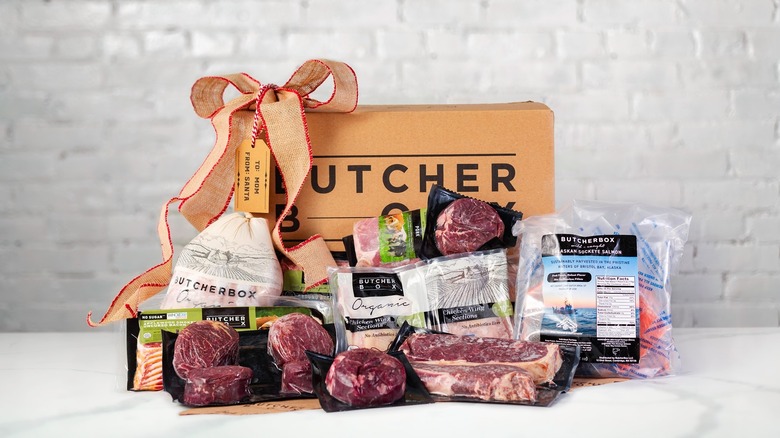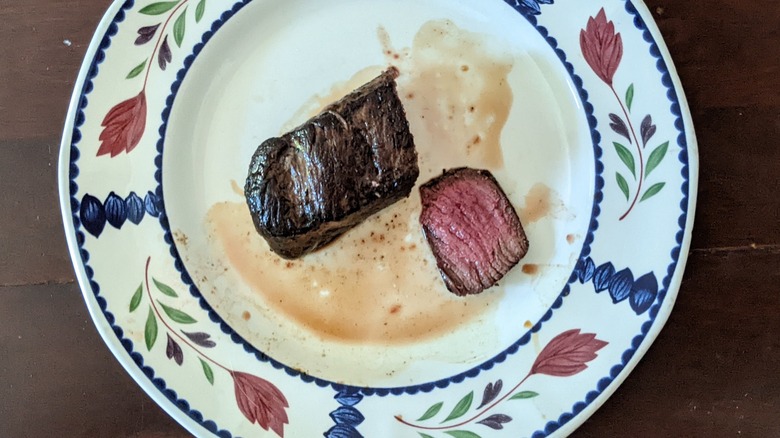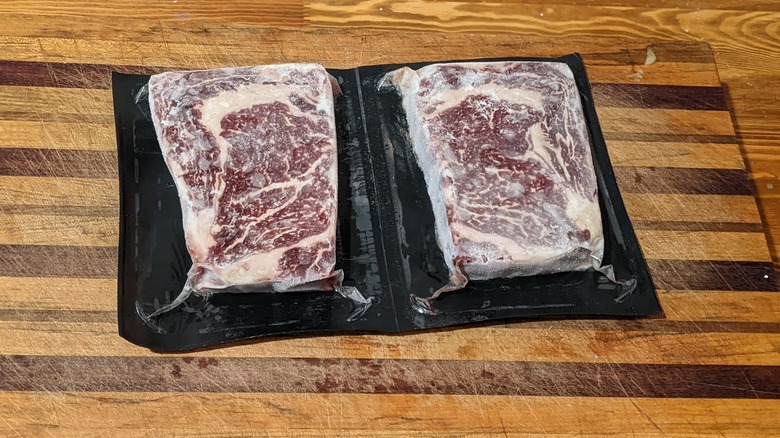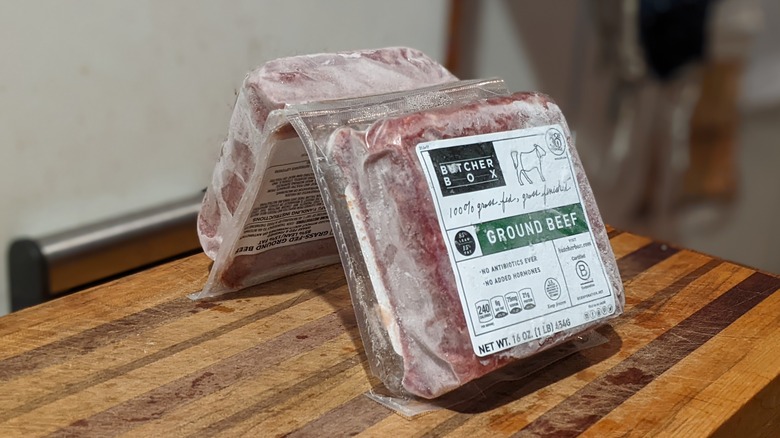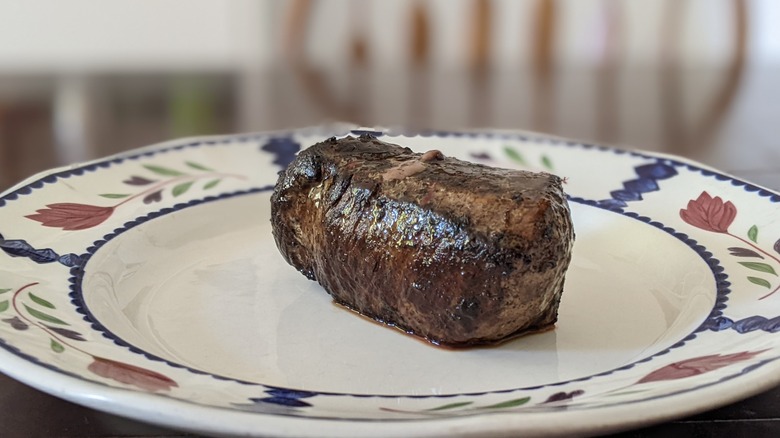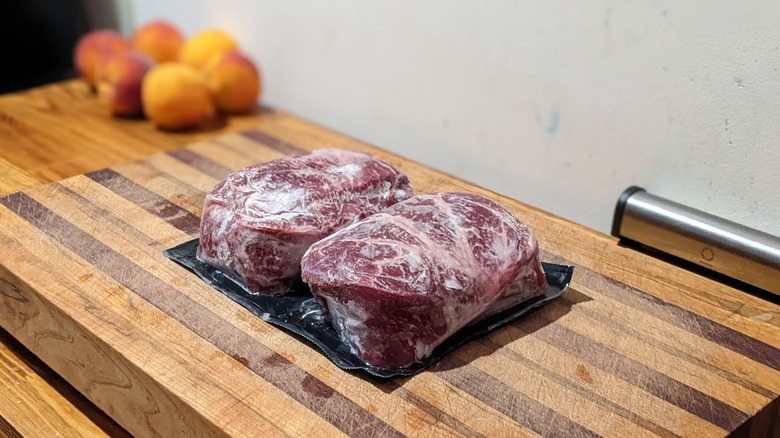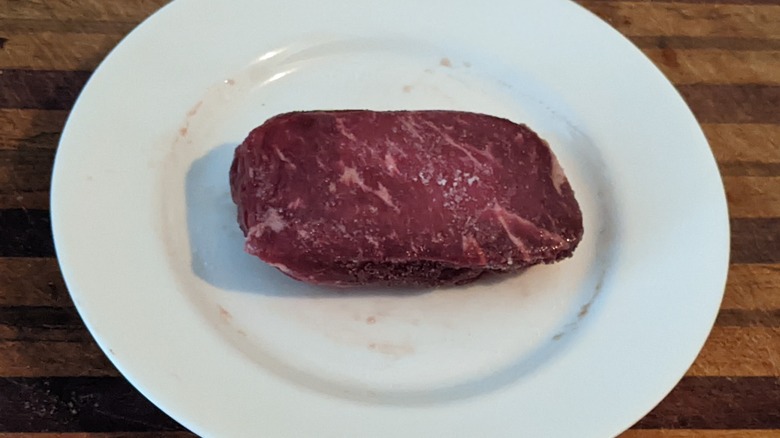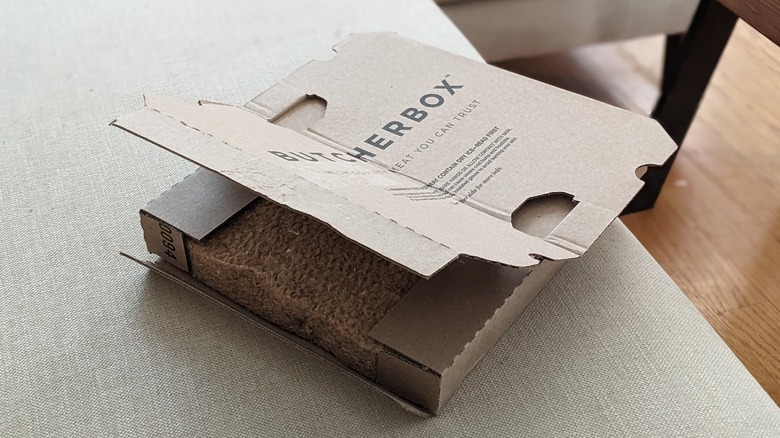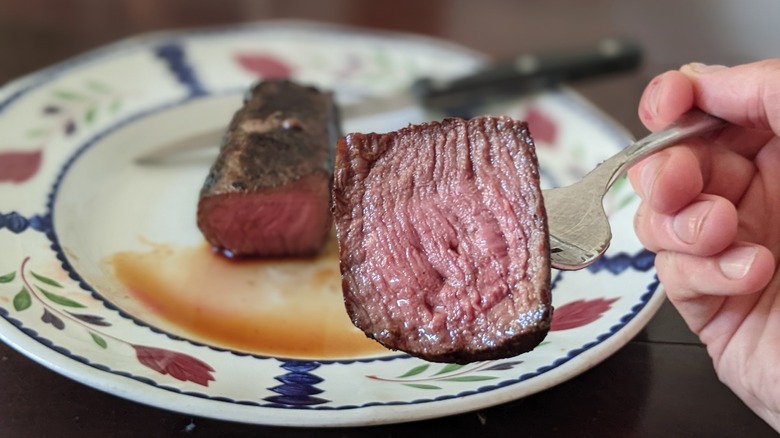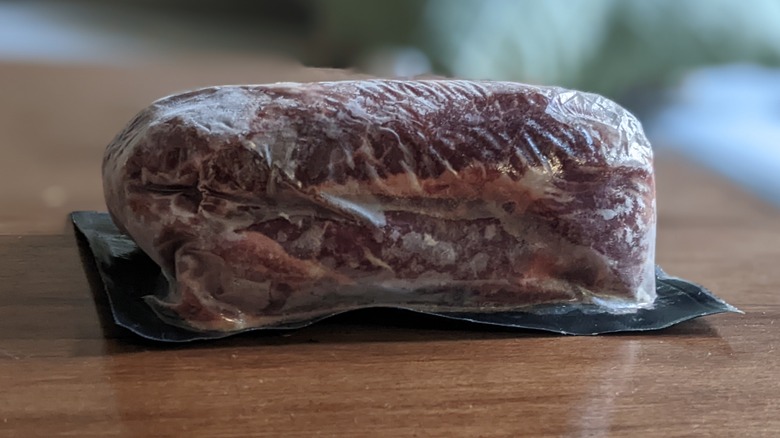Are ButcherBox Steaks Worth The Hype?
Let's face it, some subscription boxes have more legs than others. In the case of ButcherBox, those legs are very often literal. While it can be tough to work through a curated delivery of various perfumes every month, a box of meat on the welcome mat will vanish quickly for as long as omnivores need to eat. After a company solves the logistical problems of moving a box of raw meat across the country, it just has to compete with local accessibility, cost, and quality.
With a focus on grass-fed beef (and free-range other animals) raised ethically and sustainably, ButcherBox has quality down pat, along with a prioritization of morality and environmental concerns that are all-too-rare in the meat and subscription meal industries. So does ButcherBox make the grade, and is that grade prime? Let's dig into the details to see how it all works, compare it with similar options, and test whether it's worth subscribing to the meatiest of monthly deliveries.
The history of ButcherBox
Founded in 2015, according to Entrepreneur of the Year, the company ButcherBox prioritizes the biggest problems with the commercial meat industry: humane treatment of animals, environmentally sound practices, and accessibility. CEO and founder Mike Salguero wanted to put grass-fed beef with a traceable history on the table for anyone who wanted it and partnered with a local rancher to distribute a beef share through his church. From this foundation, ButcherBox emerged as a mail-order distributor of community-supported agriculture meat shares.
It's also a certified B Corporation, meaning it meets (and its meats) an exacting standard of social and environmental responsibility, accountability, and transparency. This is especially important for a meat supplier, given the industry's impact on our collective greenhouse-gas footprint; something ButcherBox is exceptionally diligent about. Animal proteins have become a literally heated topic, and ButcherBox recognizes that while some people aren't ready to give up meat, they can do everything possible to minimize its impact while making life more comfortable for the animal. The fact that these conditions are actually conducive to taste just proves there's room for change in our diets.
What meats does ButcherBox sell?
Though grass-fed and -finished beef remain the first and foremost focus, ButcherBox has expanded to offer free-range, organic chicken, traditional family-farm pork, and sockeye salmon from small fishing operations in Alaska. ButcherBox occasionally offers lamb and turkey as well. In all cases, the company prioritizes admirable requirements like sustainability, healthy and happy existences for the animals, small-business and family-owned farms, while refusing to sacrifice the quality of the meat. In fact, it's not hard to argue these things go hand-in-hand for a guarantee of enjoyment and peace of mind that quickly proves its worth.
ButcherBox sent us a sample delivery of its best-selling beef products. Its bill of lading included strip steak, flat-irons, rib eye, burger, filet mignon, and top sirloin: 7.25 pounds in all. The meat arrives at your door frozen, or near enough, that you won't worry about the quality concerns of stowing it in the freezer until you can work your way through this impressive array of animal protein.
Where it sources meat from
The commitment to quality has sent ButcherBox as far abroad as Australia to source the best beef. That may be anathema thinking to the cattle-proud states of America, but in a lengthy case for the superiority of the Australian option, ButcherBox explains the cows used in Australian ranching are ranked by clearer, high-quality standards based on taste compared to the U.S. grading system of fat-to-meat distribution, after a lifetime of happily roaming open pasture to select their own grass meals.
ButcherBox does still work with American and Canadian suppliers, but with just 4% of the U.S. beef market grass-fed, the dubiousness of grain-finishing, and the company committed to pasture-raised beef free from antibiotic and hormone supplements, the Australian option is a boon for its standards. For this reason, the land down under supplies most of ButcherBox's beef and lamb.
ButcherBox's salmon comes wild-caught from small fishing operations in Alaska, while its chicken is certified organic. The company avows that its pork producers do not use crating or farrowing, and feeds their pigs an all-vegetarian diet: again, free of hormones and antibiotics.
How to order ButcherBox
Ordering from ButcherBox could be easier. Choosing a box takes you to a sign-up page where an email gateway will resume the process with an offsite check-in at your inbox. Frankly, we'd prefer to subscribe and set up our cart from one fluid customer journey funnel on site, with the email collection coming at the end. Why? So we can poke around our options easier when we're committed to ordering. The page you really want when you're ready to pull the trigger is not "Get started," but ButcherBox's, "How it works" explanation. There, you'll find the six basic subscriptions, though the gift options are on a different section of ButcherBox entirely, which are without a sign-up obstacle.
A little unity in the user experience is all we're asking for, ButcherBox gang. Don't bounce our attention around the site when we could be compiling our own orders alongside the holiday gifts for our families.
One caveat for the paranoid-minded: To optimize its efforts, ButcherBox uses what Mashed calls a ton of data. This creates a profile of its main customer, without any evident granular privacy concerns. But it's still worth knowing if such things matter to you.
How much does it cost?
ButcherBox offers numerous options, all of which include beef unless you create a custom box (though it seems foolish to forego steak of this standard). Most options are in the eight-to-11-pound range at $146 per month, though the custom box is $169 for a projected range of nine to 14 pounds. ButcherBox touts it as 20% more meat — not a bad coupon for a 15% total cost increase. For ease of assumption at 10 pounds, that's $14.60 per pound of beef on the main boxes — and with a 20% bump in the custom order, that's $14.08 per pound. While costs compare evenly, you gain your choice of cuts on the net-cheaper option.
If budget is your primary concern, cheaper steak is found at standard markets, but ButcherBox is superior to those offerings. A more comparable shopping experience is found at premium butchers or Whole Foods Market. In NYC, where our order was received, Whole Foods Market lists most cuts of steak starting at $15 (though top round and top sirloin are currently $9 and $12, respectively).
Shopping beloved local butcher Hudson & Charles in Manhattan — probably the most similar independent butcher to ButcherBox with grass-fed and humane conditions — made the latter's advantage even clearer: Excluding dry-aged options, merlot, and minute steaks, both relatively cheap cuts, were $22 and $16 per pound. ButcherBox will save you money, time, and energy.
What's the best deal at ButcherBox?
Even if you don't eat meat often, the custom box is the clear winner in savings. The lower-cost options don't provide a dramatically lower floor in quantity or cost for intermittent carnivores, so you might as well maximize your value in a custom box. Your experience will be almost identical, except where it's better in small ways. If that's not a deal for you, just buy organic, humane meat at the grocery as needed.
ButcherBox is the best price for premium beef compared to shopping local, but $14 for steak is a much better deal than a pound of chicken. If you hanker for the clucky stuff, free-range chicken can be had at your local version of Hudson & Charles for $5.50 a pound. Focus on the red meat if you're trying to maximize your ButcherBox costs, though don't exclude pork, as heritage and humanely treated options are harder to find locally on the pig front, even if it's an animal best known for great flavor on a budget.
Finally, compare ButcherBox's gift boxes, which start at similar prices before becoming significantly more expensive per pound, but do offer benefits like rarer cuts and thematically curated selections.
Is ButcherBox delivery safe?
Shipping is included with your order, and the box arrived within a day of order confirmation, having shipped the same day. There's zero fear here of an unsafe box of food, even sitting on the doorstep. It included a personalized note, which was an appreciated touch.
All of the beef arrived in vacuum-sealed, individual packs on joined plastic backgrounds — your meat will stay grouped by its label so you don't mix anything up until you choose to cut it apart (which you may do for ease of storage).
Other than the necessary plastic wrap, the package was impressively devoted to an ecological design: After removing the delivery stickers, you're left with an all-cardboard design, even the insulation layers, which are made of pulped paper fiber. The result is a largely recyclable or easily compostable box. High marks on all points. It's impossible to point to an area of improvement here until compostable plastic becomes commercially viable. And, hey, if you use the dry ice to safely and sensibly make ice cream or fizzy frozen fruit, it's like you get dessert almost for free.
How the meat tastes
All of this, of course, is subordinate to the question of taste. After all, the effort is only as worthwhile as the outcome where steak is concerned. To keep our testing pure, steaks were seasoned with just salt to let their qualities speak for themselves. They were pan-seared and pulled off near medium-rare temperature before being left to rest for five minutes. For leaner cuts, a slight butter baste was included.
Its steak fibers surprised twice: first by being more rugged than expected across the grain, then more tender than the former would imply cutting with it. This was true even of the filet mignon. None of this was unpleasant and may have even factored into the real selling point; exceptional flavor from well-developed muscle. But if you're expecting a buttery soft filet mignon, be aware this is the musculature of an animal living an active life. You may find this quality poignant in the flatiron, which is not entirely surprising, but it is the more tender half of the blade roast.
Cuts were wonderfully juicy, with the top sirloin acting like its own French dip even by the slicing of the final piece. Don't cook your ButcherBox without a great loaf of bread handy to mop your plate clean. Keep the steak sauce clear and just enjoy these cuts on their own. Salt, pepper, that's it. Their own juices make the beef and the grassy undertones of its diet manifest and mouthwatering.
Is ButcherBox worth it?
First off, let's be clear that ButcherBox is fantastic meat, and the premium barely seems like one when you're buying a better life for the animal and the Earth. If you care about such things and aren't giving up meat, this is probably the finest option out there for you, short of buying a local CSA beef share that minimizes transit and lets you see the animals' quality of life for yourself.
And, frankly, this service fills a gap, since that's an impossibility for many people. The USDA's food access research atlas shows just how much of the country lives near prepackaged rather than fresh foods. So while ButcherBox won't make sense for everyone, it's very much worth having as an option in our society. It's ethical within its frame of reference and affordable for the benefits derived overall.
We especially like the ability to order one-off boxes as gifts. This keeps the service useful without exacting a commitment, for people who eat meat infrequently or want to try a better quality. The carnivore in your life will be delighted to see such a present arrive on their doorstep. All told, ButcherBox is a satisfying purchase. You may be able to beat it on certain points with local butchers or delivery competitors, but its final tally is an extremely well-rounded experience. You'll never be disappointed.
